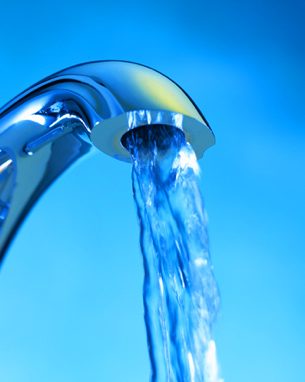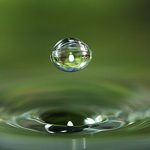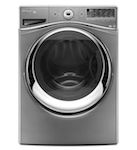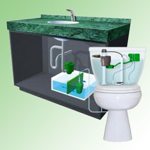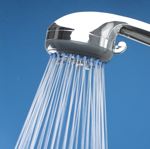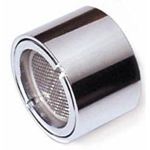Ways to Conserve Water
To those of us blessed with a wealth of fresh water, the act of water conservation does not seem all that imperative.
The truth is, most of the world suffers from a lack of fresh water, and it is up to all of us to conserve and not waste this precious resource.
Actually, taking some basic steps to conserve vast amounts of water is not all that difficult, it just involves several primary decision-making steps by the homeowner.
In this section, we will go through some baseline steps you should establish for your green home.
Then, we will offer significant systems which will conserve even more water.
Green Standard - Watersense
If you building in an area served by a municipal water system, conserving water will mean smaller water bills.
If you will be or are connected to a septic system, water conservation can prevent water pollution and prevent overloading the system. This excess water can cause bacterial contamination and overflow problems.
There are some baseline standards that we should all abide by to preserve this precious resource. This section will give you some guidelines as to how you can implement basic water conservation practices.
Read Watersense: Saving Water for more about the baseline standard in water conservation.
Water Conservation Tips
There are literally hundreds of ways each of us can conserve water at home and in our everyday lives. Some of these methods are very obvious and other not so obvious.
In this section you will find a compiled list of water conservation tips. The list is divided into use or room location, such as the bathroom, the kitchen, the garden etc.. Some of these tips are related to home construction, but most are minor adjustments each of us can make in living style. Either way, they show how we can conserve a tremendous amount of water.
For a complete listing of these informative tips, visit Water Conservation Tips.
Water Saving Toilets
The toilet, or water closet has been a notorious water hog for much of it's existence. There have been major technology advancements in toilet design over the past several decades.
Now this appliance is one of the largest water conservation opportunities in the home. So be sure to include one of these great hi-tech toilets in your home remodeling or home construction project.
We will give you the information you will require to make the correct water closet selection. Find out how by visiting Water Saving Toilets.
High-Efficiency Washers
Nobody likes doing laundry, really. But we all have to have clean clothes. Washing machines can use an incredible amount of water per load, up to 60 gallons. In addition, they use a lot of energy (gas or electric) to heat all that water. Choose a washing machine that is Energy Star rated; it's typically going to be a front loading washer that can wash up to 30% more clothes per load while using 50% to 60% less water per load.
High Efficiency Washers can saving hundreds of gallons of water per year. They can also save up to 70% on energy costs associated with washing clothes.
For more information on high-efficiency washing machines, read our review of the Whirlpool Duet machine HERE.
Greywater Systems
Well over 38,000 gallons of water is used by the average family of four during the year and most of this water goes down the drain. The fact is this; most of the water used for laundry, service sinks, showers and lavatories is all reusable.
In order to reclaim this water, there has to be a system in place to do so. That is where grey water reclamation systems come into use.
Find out what they are, how to design them and what they cost in our section of Greywater Systems.
Rainwater Harvesting System
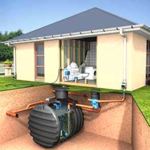
Rainwater Harvesting
Did you know that with a 1 inch rainfall on a 1,000 sq. ft. roof, you can capture up to 520 gallons of usable water that can be reused? If you are in a area that receives an annual rainfall of 40 inches per year, that works out to a total of 20,800 gallons of usable water for each 1,000 square foot of roof area.
Water collection systems are rather basic and can be very inexpensive. You can also utilize elements already in place with almost any home building project. By making smart, informative decisions, you can implement a very efficient, cost-effective system by following our tips and techniques. Visit the section Rainwater Harvesting Systems for more information about the reuse of rain water.
Low Flow Shower Heads
A standard low-flow shower head delivers approximately 2.5 gallons of water per minute. A high quality shower head will deliver this amount of water or even less, while maintaining a comfortable flow of water.
There are many models that adjust the water delivery automatically depending of water pressure that is available and save a lot of water during the typical shower. We will review what is available and which ones you should select to install in your home.
Visit the page Low Flow Shower Head to find out what to look for and how to purchase the latest water conservation shower heads.
Faucet Aerators
Faucet aerators are installed at the end of a typical sink or lavatory faucet. Their function is to spread the stream of water into smaller droplets rather than one big stream of water.
The aerator also introduces air into the water flow to give it the illusion of more water being delivered than actually is.
Additionally, faucet aerators can deliver greater water pressure to faucets in areas of low water pressure. To learn more, visit Faucet Aerators.
Garden Water Systems
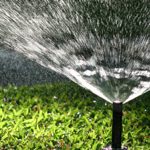
Garden Water Systems
The lawn, garden and landscape consume a tremendous amount of fresh water. You can implement several water conservation techniques in the design stage of your new home that cost very little and will save big on your water bill.
Visit the page Garden Water Systems for great tips on saving water in the landscape.
Also, you will find lots of great ways to conserve water in the landscape, your lawn and garden at our site Green Landscape Source.
Composting Toilets
For hardcore water conservationists, composting toilets are gaining popularity.
Composting toilets use the aerobic biological process of decomposition to turn waste into carbon dioxide, water vapor, and a dry odorless compost material that is perfect for fertilizing non-food plants.
Learn more about Composting Toilets HERE.
comments powered by Disqus























































































































































































